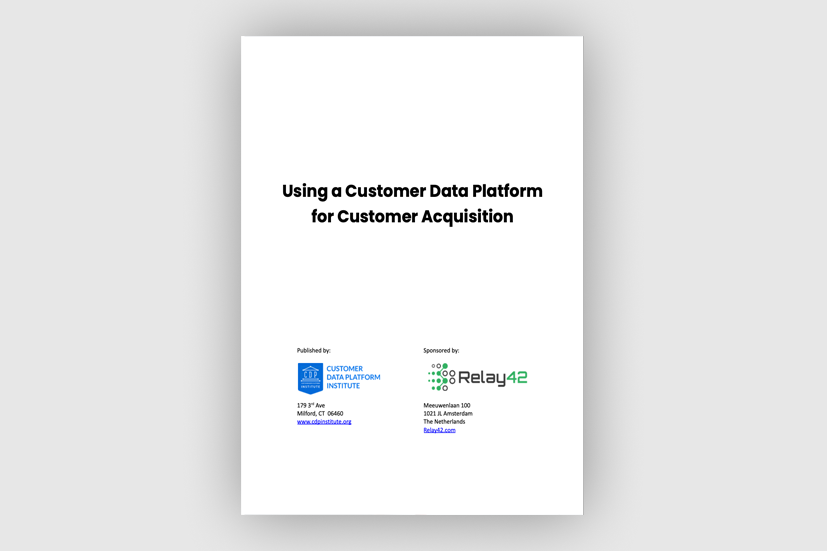Customer Acquisition is Harder Than Ever in 2025. Here’s How the Right CDP Can Help
by Anthony Botibol on 1.4.2025

Customer acquisition has never been easy, but today, finding and converting new customers is becoming tougher than ever before. Marketing budgets remain heavily weighted towards acquisition, yet marketers are increasingly challenged to find and effectively engage the right prospects.
Why is Customer Acquisition Getting Harder?
Several factors have made customer acquisition particularly challenging:
- Increasing Privacy Regulations and Consumer Controls: Stricter data privacy laws and the growing use of ad blockers and privacy-safe browsers make it more difficult to identify and engage target customers effectively.
- Brand Safety Concerns: Ensuring ads do not appear alongside offensive or harmful content, especially on platforms with relaxed moderation like social media, poses ongoing challenges.
- Fragmented Media Consumption: Today's consumers explore diverse channels—connected TV, social influencers, gaming, and retail media—making it difficult for marketers to determine the most effective channels for investment.
- Economic Uncertainty: Consumers, cautious about spending, are less willing to experiment with new brands, increasing the stakes for acquisition marketing.
Moreover, major advertising platforms like Google and Meta, with their opaque bidding algorithms and audience expansion settings, frequently encourage rather than prevent media waste, often leading to overspending and inefficiencies.
Leveraging First-Party Data and the Right CDP for Better Results
To navigate these challenges effectively, brands must maximize the value of their first-party data using the right Customer Data Platform (CDP). However, not all CDPs are created equal - those originating from marketing automation systems typically excel in direct channels like email and SMS but fall short in supporting paid media and inbound web and eCommerce channels.
Optimizing these critical acquisition channels demands capabilities like:
- Real-Time Data Streaming and Processing: Quickly capturing and processing large volumes of clickstream data in real-time to personalize experiences effectively.
- Cross-Session and Cross-Channel Identity Stitching: Accurately linking anonymous visitor behaviors over multiple sessions and across channels to build a complete prospect profile.
- Real-Time Decisioning and Activation: Dynamically personalizing interactions based on immediate (and past) visitor behaviors, especially crucial for anonymous visitors.
- Advanced Predictive AI: Identifying and excluding up to 20% of unlikely buyers based on predictive scoring, reducing media spend while maintaining or improving conversion rates.
These real-time capabilities ensure your marketing is targeted, relevant, and efficient, significantly reducing waste.
Why One CDP Might Not Be Enough
Brands that have already invested in a CDP might assume their acquisition use cases are covered, but this isn't always true. A marketing-automation-originated CDP, categorized as a ‘Delivery CDP’ by the CDP Institute, is likely optimized primarily for known-customer retention and engagement rather than anonymous visitor acquisition and paid media efficiency.
Marketing teams invested in these Delivery CDPs will find paid media channel integrations are available as a one way push of ‘known’ customers and prospects (i.e. those that have provide their email or phone number in the past), and find that any on-site personalization capabilities are limited to a single session and not able to recognize an anonymous browser over multiple visits in their journey.
As a result, marketing teams find they have limitations when it comes to use cases related to acquiring more customers, or optimizing Customer Acquisition Costs (CAC).
The CDP Institute highlights that businesses may increasingly turn to multiple CDPs, each specialized for different purposes. This ensures optimal performance across all use cases, particularly in customer acquisition, where real-time data capabilities are crucial.
Ready to Optimize Your Acquisition Marketing?
 To dive deeper into how a CDP can power your customer acquisition strategy, reduce media waste, and deliver better personalization, download the CDP Institute white paper "Using a Customer Data Platform for Customer Acquisition."
To dive deeper into how a CDP can power your customer acquisition strategy, reduce media waste, and deliver better personalization, download the CDP Institute white paper "Using a Customer Data Platform for Customer Acquisition."
You May Also Like
These Related Stories
.jpg)
Moving to Server-Side Analytics? Here’s How to Make the Most of It

3 Ways a Customer Data Platform Delivers More Revenue



.png?width=786&height=265&name=Relay42%20Demo%20Banner%20(1).png)